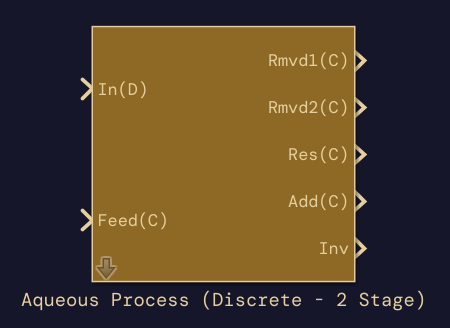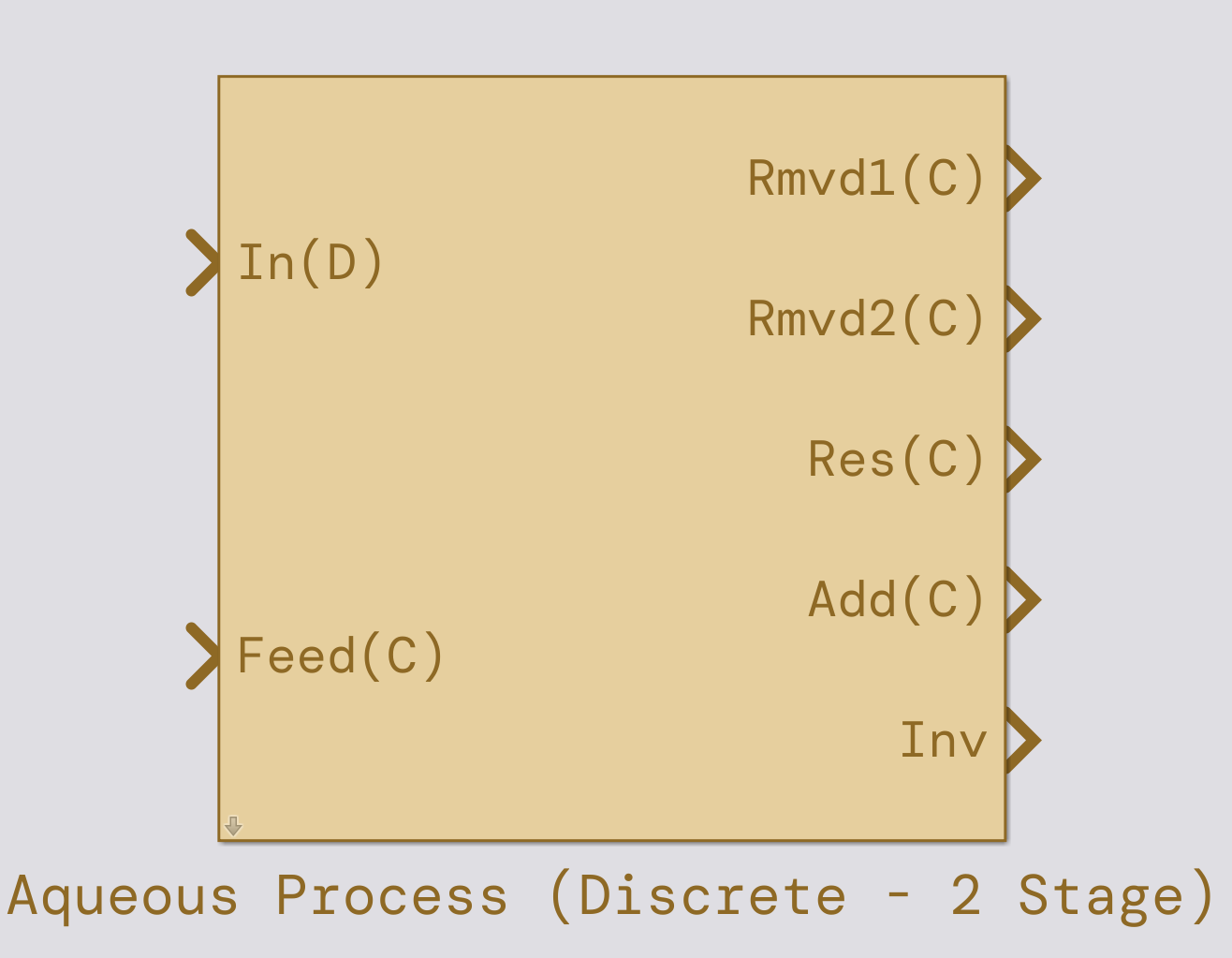Aqueous Process (Discrete - 2 Stage)#
Library:
Fissile Facility Flow Modeler/Aqueous
Description#
This block belongs to the larger group of aqueous process blocks. Specifically, this discrete - 2 stage blocks accepts an input entity, converts it to a signal, passes the signal through a maximum of two sequential stages, and outputs a continuous signal. The user can also specify additional materials to add to the process, either using the Feed(C) inport or by specifying species in the additions dialog table. If the dialog table is used, material is only added when entities arrive. The Add(C) output provides a signal that describes material that is added by the dialog table, if used.
The stages in this block are simple sequential removal blocks. Users can specify entities or isotopes to remove from a stream, in terms of fractional removals. For example, a removal of 0.50 means that 50% of the incoming entity is removed for the specified entity or isotope. The two stages of this block are sequential, so the ultimate output of this block, Res(C), has had both stages of specified removal fractions applied.
This block operates according to the specified on/off points. If the process inventory is below the off point, flow out stops. Similarly, if the inventory is above the on point, flow out proceeds. The flow rate of the block can be specified as a certain value or the output flowrate can be matched to equal the input.
Important
The flow rate specified in the mask dialog option is the rate before any processing has occurred. Consequently, the Res(C) might be less than the specified rate as the flow out rate is equal to Res(C)+Rmvd1(C)+Rmvd2(C).
Mask dialog options#
- Process level basis : string
The element or isotope used for the process level min and max.
- Process off point (kg) : float
The switch off level for the process. If the process inventory of the element or isotope specified in
Process level basisfalls below this value, then flow out from the block is prohibited.- Process on point (kg) : float
The switch on level of the process. If the process inventory of the element or isotope specified in
Process level basisrises above this value, then flow out from the block is permitted.- Match inflow : boolean
If selected, then the output flow from this block will match the input flow.
- Flowrate (kg/hr) : float
The flowrate out for the process in kg/hr.
- Additions : string, float
An optional table of strings specifying a species (either elemental or isotopic) and a flow rate. If this table is used, materials are only added when entities are arriving through
In(D).- Stage 1 Efficiencies : string, float
A table of strings specifying a species (either elemental or isotopic) and removal fraction. The signal created from entities entering
In(D)will be reduced according to this table.- Stage 2 Efficiencies : string, float
A table of strings specifying a species (either elemental or isotopic) and removal fraction. The signal from the prior stage will be reduced according to this table.
Note
Values in the additions and stage tables should be specified in order of descending inclusivity. For example, the user should set all before c. Similarly, c should be specified before c12. The table is processed row by row, so specifications in later rows will override earlier row specifications (if applicable).
Ports#
- In(D) : entity
Entity to process. Expects an entity with attributes:
isovec (signal): Has shape [1677, 1] that represents the different isotopes tracked by F3M
auxparam (scalar): Function varies based on user implementation
- Feed(C) : signal
Optional feed signal. Should have shape [1677, 1].
Outputs#
- Rmvd1(C) : signal
The component of
In(D), after conversion to a continuous signal, that was removed by the first stage.- Rmvd2(C) : signal
The component of
Rmvd1(C)that was removed by the second stage.- Res(C): signal
The final transformed signal.
In(D)after conversion to a continuous signal and application of both user specified stages.- Add(C): signal
Signal that represents material that is being added by the additions dialog table. Can be used for consistency checks.
- Inv : signal
Continuous inventory signal with shape [1677, 1]. Updated when entities enter and the residual signal leaves.


